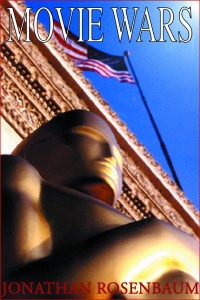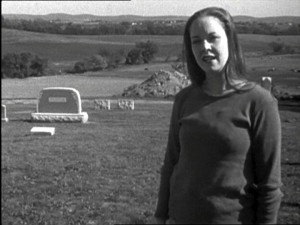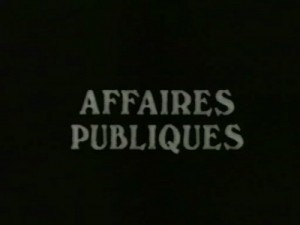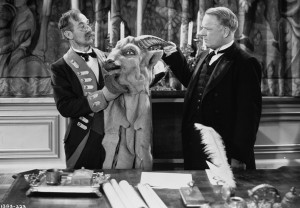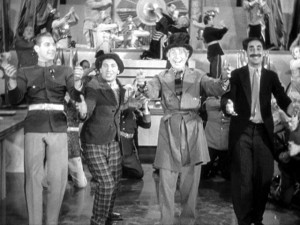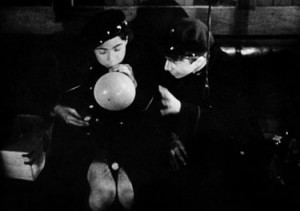Chapter Seven of my book Movie Wars: How Hollywood and the Media Limit What Films We Can See (Chicago: A Cappella Books, 2000). The cover below is that of the U.K. edition published by the Wallflower Press. Because of the length of this chapter, I’ll be posting it in two parts. — J.R.
Is it possible that because of the rise of the new media, which have given us the ability to manufacture what we call virtual reality, we are now able, without quite knowing what we are doing, to create a secondary world that we are liable to mistake for the primary world given to our senses at birth? If so, the prime need it serves is probably not political at all but the one Freud identified as the chief motive for dreaming: wish fulfill-‐ ment—a need catered to both by our luxuriously proliferating sources of entertainment and the means of their support, namely, advertisement of consumer products. In our variant of self-‐deception, pleasure plays the role that terror plays under totalitarianism.
— Jonathan Schell, “Land of Dreams,” The Nation, January 11/18, 1999
This chapter and the next explore complementary and mutually alienating attitudes: the desire to keep out foreign influences in order to preserve American “purity,” and the fact that what we consider American “purity” is often composed of foreign influences. In other words, our desire to keep our movies American doesn’t make sense if we no longer have a clear idea of what “American” is. Globalization is the major reason for this confusion, though it goes under different names and affects us through different manifestations.
I recently heard about an American teenager visiting Wales who insisted on calling all the Welsh people she met English. When it was pointed out to her that the Welsh didn’t like being identified that way, she said she was sorry but that’s what she was taught in school and at this point it was too complicated for her to change, regardless of how Welsh people happened to feel.
The fact that she’s a teenager is probably pertinent; raging hormones make it even harder than usual to deal with ambiguities. But why is it that only an American can readily be imagined making such a remark, or arriving at such a conclusion? Maybe it’s because once you’re taught to view everything outside the United States as somewhat unreal — and every other country as a failed or imperfect version of the United States — anything becomes possible, including this special brand of solipsism.
There are plenty of other kinds as well — such as Americans who wouldn’t be caught dead in an American art museum making tracks for the Louvre as soon as they hit Paris, presumably so they won’t have to confront too many Parisians. And not so many years ago, President George Bush made his case against national health by claiming that it was an obvious failure in Canada — the sort of statement that can confidently be made only to some innocent Americans who never set foot outside this country.
Precisely for this reason, even bad or mediocre foreign movies have important things to teach us. Consider them cultural CARE packages, precious news bulletins, breaths of air (fresh or stale) from diverse corners of the globe; however you look at them, they’re proof positive that Americans aren’t the only human beings and that the decisions we make about how to live our lives aren’t the only options available — at least not yet.
As strange as it sounds, this is fast becoming an endangered position. I assume that writer‐director Kevin Smith was well past his teens when he told an interviewer a few years back, “I don’t feel that I have to go back and view European or other foreign films because I feel like these guys [i.e., Jim Jarmusch and others] have already done it for me, and I’m getting it filtered through them. That ethic works for me.” It shouldn’t be surprising that Jarmusch was as appalled by Smith’s statement as I was, if only for what it reveals about a certain kind of landlocked naiveté — the kind that assumes that world cinema, and therefore the world, can be categorized and summarized so simply. But it isn’t all that different, really, from the kind of sweeping judgments that can easily pass for cleverness in our culture. “One of the extraordinary advantages of growing up French,” began David Denby’s review of Catherine Breillat’s Romance in The New Yorker, “is that you can be absurd without ever quite knowing it” — an advantage presumably denied to world-weary Americans such as himself. To find such a statement funny and/or true, it helps if you glide past the fact that it’s describing fifty‐eight million living people, none of whom Denby evidently imagines reading his sentence. If a French critic made the same statement about growing up American, I wager that most of us would find the remark stupid. But too many Americans feel licensed to define the rest of the world, cheerfully and without shame, in terms of their own limitations.
About a decade ago, when I was looking for a VCR that would play foreign videos in PAL and SECAM formats on an American NTSC monitor, I came across some interesting fliers describing these machines. While arguing how useful such VCRs were, the ad writers invariably assumed that the only reason an American would want one was to convert NTSC videos to PAL or SECAM formats so they could be sent overseas. The idea that an American might actually want to look at videos from overseas seemed so unlikely that the notion of attracting such individuals never came up.
That a good many Americans are interested in seeing foreign movies, including some that exist only overseas, isn’t really a matter of dispute. I get e-mails from such people every week inquiring where they can find certain foreign films on video and sometimes proposing various swaps, and there are many specialized video sale outlets — Facets Multimedia in Chicago and Video Search of Miami, for example — catering principally to that market. Of course, these people are generally only interested in finding films discussed in books and magazines; as a service to its customers, Video Search of Miami, which specializes in cult genre movies, lists twenty such magazines, ranging from Asian Cult Cinema to Video Watchdog.
But people can only be interested in films that they know about, and given the lack of interest in the mass media in anything that isn’t already omnipresent, the range of what people are likely to know about is shrinking rapidly. That’s why the themes of innocence and ignorance strike a chord in young audiences despite the supposed cynicism that the press keeps attributing to them. On some level Americans are aware of their own isolation from the rest of the world as well as their crippling lack of information, and The Blair Witch Project — the independent, no-budget horror feature that became a runaway hit during the summer of 1999 — may have derived much of its power from that implicit recognition, expressed in the mounting sense of helplessness experienced by a trio of film students lost in the woods.
Apart from the film’s capacity to allegorize this sense of isolation and ignorance, using an audience’s own imagination as paint box, one might have thought that its unexpected commercial success might have been celebrated in the press as a welcome challenge to the dominance of special effects and other production values foisted on the public by the studios. After all, this was a clear sign that the audience wasn’t simply kowtowing to the limited options offered by blockbusters like The Phantom Menace. Yet the national press perversely chose to extract the reverse meaning out of this grassroots expression. In a provocative article in the New York Observer (August 23, 1999), “Blair Witch Innocence Scares Media Fatheads,” Philip Weiss noted that
Time and Newsweek both put Blair Witch on the cover four weeks after it premiered and tried to argue that some calculated acts of hype had created the phenomenon. Their articles talk about Sundance, a giant team of marketers, the Internet and some cool TV shows. The New York Times also said that the Internet had been used skillfully to push the film.
But all this is a self-‐justifying media delusion: Something can only succeed by cagey manipulation of the media. Time even ended its timeline of the marketing of Blair Witch with the Aug. 16 Time cover— as if that were part of the plan. The cover of Time would have killed this picture. Any big hype would have killed it. There wouldn’t have been a Time cover in the first place. All the 40ish editors in the mainstream would have checked their watches — as I did — through the movie. The media are just playing catch-up to the viewers. The response to Blair Witch is a populist response that has nothing to do with hype.
As Weiss suggests, the media have a vested interest in proving that the audience is just as corrupt as their own coverage of movies implies. And the moment the audience dares to confound this stereotype and think for itself, a concerted effort is made to demonstrate that the gullible public is merely responding to hype. Consequently, the critical backlash against the popularity of The Blair Witch Project, a backlash that essentially equated popularity with hype, came even from such unexpected quarters as Stuart Klawans in The Nation and maverick independent filmmaker Jon Jost on the Internet.
***
A 1999 traveling retrospective of the complete works of French filmmaker Robert Bresson – omitting only his first film, Affaires publiques (1934), which preceded his first feature by nine years, at Bresson’s own request (largely because it survives only in incomplete form) — offered another encouraging sign that the audience wasn’t half as jaded as it was cracked up to be. Throughout his career, stretching from Les anges du péché in 1943 to L’argent in 1983, and encompassing thirteen features, Bresson has been widely and correctly regarded as one of the essential figures in the history of world cinema, but getting Americans into theaters to see his films was generally believed to be almost impossible. I don’t mean to suggest by this that his films fared especially well elsewhere, even in France; apart from his third and fourth features, Diary of a Country Priest (1951) and A Man Escaped (1956), which did respectably as art-house releases around the world, he was fatally considered an esoteric director whose films audiences found boring, stilted, and pretentious. In part because of Bresson’s refusal, starting with his third feature, to employ professional actors, as well as his insistence on directing his “models” (as he called them) to read their lines as tonelessly as possible, the public ridiculed, when it did not ignore, his work; and only a small band of enthusiasts — including a significant number of other filmmakers — persisted in defending his films. Needless to say, the fact that all these features were foreign and subtitled — excepting only an English-dubbed version of Diary of a Country Priest that circulated in 16-millimeter — only made things worse.
So one might have supposed that when James Quandt, the ambitious director of the Cinémathèque Ontario in Toronto, began organizing a substantial Bresson retrospective, with brand‐new 35‐millimeter prints struck of all the features, he was doomed to fight the same uphill battle. Yet this series of thirteen features was a big success practically everywhere it showed in the United States, attracting turn‐away crowds in New York, Chicago, Los Angeles, and Washington, D.C., and showing in fifteen separate venues nationwide before returning to some of those cities for encore engagements. (According to Quandt’s most recent gleanings, apparently only Houston failed to attract a sizable audience.)
What brought about this substantial change in Bresson’s popularity? Some would argue that it was merely a matter of time, and it’s certainly true that the cumulative spadework of critics who were Bresson enthusiasts over the years undoubtedly led to more mainstream articles about him in The New Yorker and The New York Times when the Bresson retrospective was launched in New York. (The latter of these, by Dave Kehr, was substantially more sophisticated than the former, by Anthony Lane, but both performed the invaluable job of getting the word out.) Another reason might be the industry truism that in order for a film or series of films to be commercially successful, it has to have the status of an “event” — meaning, I suppose, that a retrospective with new prints qualifies as an event and that the prior commercial release of a single Bresson masterpiece (say, Au hasard Balthazar) apparently doesn’t. The overall critical consensus greeting the retrospective was something relatively new; none of Bresson’s individual features had received that sort of universal acclaim when they first appeared. And it was cheering to discover that the traditional role of journalistic criticism in simply bringing the news can still pay off with a foreign director as supposedly difficult and as esoteric as Bresson — another strong indication that the alleged dimness and crassness of the American public is simply a matter of guilt by association that deflects from the responsibility of critics, distributors, and exhibitors.
***
Ten years ago, I flew all the way from Chicago to the San Francisco Film Festival for a weekend to see Bresson’s first film — which had been discovered in incomplete form at the Cinémathèque Française, bearing the title Béby Inauguré. Shorn of three of its musical numbers and now totaling twenty‐three minutes, this rather elaborate piece of slapstick and surrealist tomfoolery was written and directed by Bresson and released in 1934, a full nine years before shooting started on his first feature, Les Anges du péché, and I had been hearing about it for years as an irretrievably lost curiosity. When asked in some interview what the film was like, Bresson had reportedly replied, “Like Buster Keaton, only much, much worse.” But then, after the incomplete print was found, I heard that he was pleased rather than appalled about the recovery.
Prior to the festival screening, the director and screenwriter Paul Schrader, who hadn’t yet seen the film either, offered a detailed introduction that outlined his transcendental interpretation of Bresson’s work. And in a way this totally irrelevant and incongruous preparation for Affaires Publiques proved to be almost as hilarious as the film itself, as if one of the royal dignitaries ridiculed by Bresson in the film had offered his own thumbnail sketch of the proceedings. Though a sense of humor has never been one of Schrader’s strong points — even if one discounts the apparently unconscious humor of the newspaper headline “Fall from Grace” in Late Sleeper, one of his better movies — his dogged efforts to enforce a metaphysical reading of one of the world’s most physical filmmakers were completely derailed by the film itself, which is a good deal closer to Million Dollar Legs, Duck Soup, and Jean Vigo’s Zéro de conduite in spirit — not to mention Alfred Jarry’s Ubu roi — than it is to either Diary of a Country Priest or Pickpocket.
As it happens, Schrader’s wasn’t the only blatant critical gaffe I encountered at the festival that year. The same weekend, I was lucky enough to see Souleymane Cissé’s sublime Yeelen for the first time, and was shocked to learn from Michael Sragow that this film as well as Tian Zhuangzhuang’s remarkable The Horse Thief demonstrated that the San Francisco Film Festival was more interested in ethnography than in art. To my mind, both misreadings ultimately stem from a reluctance to deal with film in terms of sound and image; Schrader’s spiritual grid and Sragow’s ethnocentric (i.e., racist) grid both derive from personal agendas that factor out much of what the filmmakers are doing.
Part of the problem we have in seeing (and hearing) Bresson clearly is that we tend to stereotype him in relation to a system. A similar conundrum haunts our simplistic and idealistic readings of Yasujiro Ozu, and the bracing lucidity of Shigehiko Hasumi’s groundbreaking 1983 book on Ozu, a French translation and adaptation of which was published in 1998 by Cahiers du cinéma, points beyond these limits. Explicitly countering the transcendental readings of Ozu by Schrader, Donald Richie, and others, Hasumi also seeks to liberate Ozu from the negative descriptions that have encrusted most of the criticism about his work and the characterizations of that work as “typically” Japanese. The final chapter of Hasumi’s book, “Sunny Skies,” is available in English in the collection of essays on Tokyo Story edited by David Desser for Cambridge University Press (1997), and one sentence in particular seems equally applicable to Bresson: “Ozu’s talent lies in choosing an image that can function poetically at a particular moment by being assimilated into the film, not by affixing to the film the image of an object that is considered poetic in a domain outside the film.”
***
The other day I received an e-‐mail from someone wanting to know how I could have described The Tree of Wooden Clogs as Marxist when it was so clearly a religious film. Actually it was Dave Kehr who had written the Chicago Reader’s capsule review of Ermanno Olmi’s feature in 1985, two years before I’d started work on that paper, but I hastily e‐mailed back that any Italian would tell you that Marxism could easily be seen as a form of religion. Afterward I realized that this response was flip. It would have been better to say that Catholicism and Marxism have had a long and complex coexistence in Italy, and it was unrealistic to expect that they would be mutually exclusive as systems of belief; the career of Pier Paolo Pasolini is proof of how intimately the two can be intertwined, regardless of the contradictions involved. That led me to think about how the similar characterizations of European Marxism in this country foster such confusion. Shortly after this I happened to read André Bazin’s description of The Bicycle Thief as one of the great Communist films — an aspect of the film I suspect couldn’t have been apparent to American audiences when it won the Oscar for best foreign film in 1949.
Given our extreme isolationism — arguably even greater today than it was half a century ago — it’s logical that we should think of foreigners in stereotypical terms because we have so little information and experience to draw upon; similarly, we often think of non‐Americans as wannabe Americans. So, out of necessity, we wind up thinking about much of the rest of the world in shorthand: Communists are nonreligious, the French worship Jerry Lewis, Iranians are subject to heavy censorship in the arts, the Chinese produce fortune cookies. That there are plenty of religious Communists, that most contemporary French viewers prefer Woody Allen to Jerry Lewis, that Iranians tend to revere artists more than we do, and that Chinese fortune cookies are strictly for export are lesser‐known facts because they interfere with our ready‐made formulas. At most such data offers fleeting clues about what usually escapes our radar, and unless we can combine them with additional information, they’re likely to be helpful only as counter-‐stereotypes, not as understandings of these foreign cultures.
Dimness about geography and dimness about history often go hand in hand. When I recently taught a class on Luis Buñuel’s The Discreet Charm of the Bourgeoisie, the main stumbling block for the students — most of whom were adults rather than teenagers — appeared to be historical rather than geographical. That is, the problem wasn’t that the filmmaker was Spanish or that the dialogue was in French but that this radically discontinuous and unorthodox narrative feature had won the Oscar for best foreign film in 1972. Considering how impossible this would have been had the same feature been released in 1999, the students — most of whom had been alive and conscious of what was happening in the world back in 1972 — couldn’t figure out how and why things had changed so much since then.
(to be continued)

